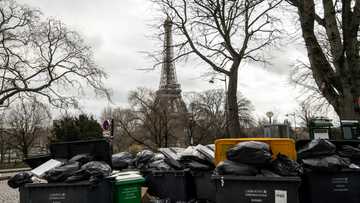California's desert farmers defend their river rights

Source: AFP
PAY ATTENTION: Enjoy reading our stories? Join YEN.com.gh's Telegram channel for more!
A blanket of crops covers the floor of the Imperial Valley in southern California, a patchwork of vibrant greens given life by the Colorado River in a landscape bleached by the desert sun.
But as a decades-long drought desiccates the US West and the once-mighty river dwindles, questions are being asked about why a handful of farmers are allowed to take as much water as all of Nevada and Arizona combined.
"We average less than two inches (five centimeters) of rainfall per year," fourth generation farmer Andrew Leimgruber told AFP.
"So without the supply of Colorado River water coming here, there would be no one living here, there'd be nothing being grown here, this would be a desert."

Source: AFP
PAY ATTENTION: Follow us on Instagram - get the most important news directly in your favourite app!
The valley, along with Yuma in Arizona, is a vital part of America's huge agricultural sector, producing most of the vegetables the United States eats over winter, in a business that generates around $2 billion a year.
Farmers here also grow alfalfa, a forage crop supplied to beef and dairy ranchers.
Ancient agreement
The land here has always been fertile, but it's always been dry.
The pioneers who forged the West realized that with its permanent sunshine, Imperial Valley could produce crops year-round to feed a growing population, as long as they could keep the fields watered.

Source: AFP
Their solution was to build an 80-mile (130-kilometer) canal from the Colorado River, positioning themselves at the head of the queue for the rights to that river.
An agreement hashed out over a century ago allows Imperial Valley farmers to use 3.1 million acre-feet of water every year -- about 70 percent of all the water California is allowed to take.
An acre-foot refers to an acre covered in water a foot deep, which equals some 326,000 gallons (1.23 million liters) or about half an Olympic-size swimming pool.
But as human-caused climate change worsens a drought that has now lasted more than two decades, the river is struggling to keep up with demand.
The 40 million people in the West who rely on it, including in some of America's biggest cities, are being told they need to cut back.
Residents of Los Angeles last year faced fines for watering their gardens too often, and are urged to take only short showers instead of baths.
The predicament has pitted suburban homeowners surveying their brown lawns against nearby farmers.

Source: AFP
"As the largest water user on the river, we become a target because it becomes an easy solution," says Tina Shields of the Imperial County Irrigation District.
"We're not going to sacrifice our community for urban sprawl and urban development and other areas."
In any case, says Shields, many of the people who complain about farmers using water are happy to fill their refrigerators with the food they produce.
"We grow a half million acres a year of crops that feed our nation and other nations as well. So it's critical to our community and our economy in particular."
'No lack of work'
Despite its water wealth, Imperial County is one of the poorest in California and would struggle to survive without agriculture.
Rural workers, mostly Latinos, come from a wide area, including across the Mexican border several dozen miles away, to earn money in the fields.

Source: AFP
"There has been no lack of work here," says Ramon Cardenas, who has toiled for three decades under summer temperatures that regularly top 100 degrees Fahrenheit (38 degrees Celsius).
Some farmers have cut deals with power generation companies, signing long-term leases that see crops replaced by solar panels.
They might not be using water anymore, but neither are they offering work.
Cardenas hopes the trend won't spread.
"We depend on this," he says gesturing to the crew picking lettuce.
Productive land
Despite a very wet California winter, Imperial Valley hasn't gotten much rain this year.
As Leimgruber's sprinklers spray hundreds of liters (gallons) of water onto a field, he insists it is well used.
Even thirsty alfalfa -- around 15 percent of which he says is exported -- is vital for a country that consumes so much meat and dairy, he says.

Source: AFP
"California is the top dairy-producing state in the country, and that's because of the Imperial Valley's ability to plant alfalfa," he says.
"A lot of Americans don't think it's possible to see empty shelves, and it's areas like this that ensure the country is fed and I think that has to be protected."
And, he insists, if Imperial Valley didn't produce the alfalfa, other suppliers would simply step in and fill the void.
Why, he questions, should he and his fellow farmers miss out on that?
"People don't understand how productive this land is," he says.
New feature: Сheck out news that is picked for YOU ➡️ click on “Recommended for you” and enjoy!
Source: AFP






